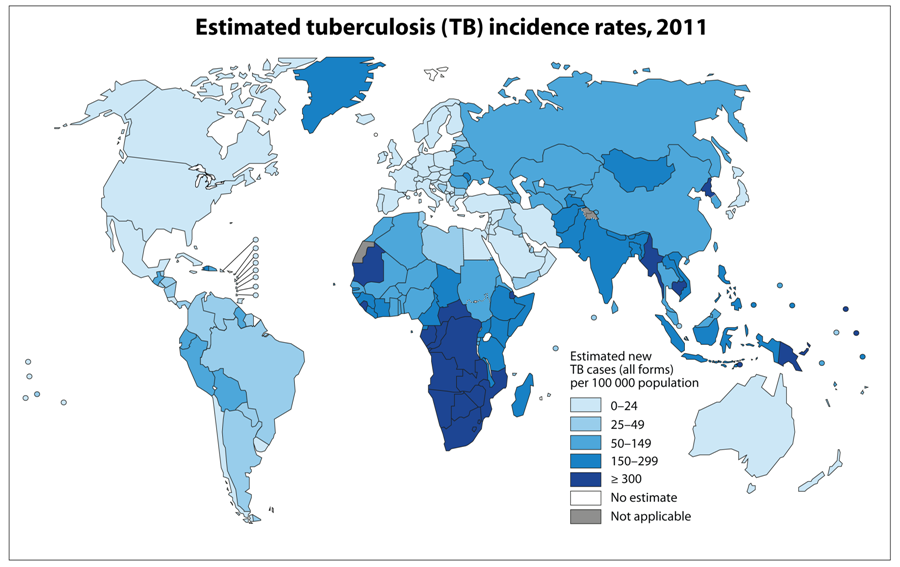Tuberculosis is a widespread infectious disease caused by various strains of mycobacteria, usually Mycobacterium tuberculosis, which if left untreated, kills more than 50% of those infected. The bacteria usually attack the lungs, but TB bacteria can attack any part of the body such as the kidney, spine, and brain.
Tuberculosis (TB) is second only to HIV/AIDS as the greatest killer worldwide due to a single infectious agent. In 2012, 8.6 million people fell ill with TB and 1.3 million died from TB.
One-third of the world's population is thought to have been infected with M. tuberculosis, with new infections occurring in about 1% of the population each year. The rate of tuberculosis in different areas varies across the globe; about 80% of the population in many Asian and African countries tests positive in tuberculin tests, while only 5-10% of the United States population tests positive.
Types
Although your body may harbor the bacteria that cause tuberculosis, your immune system usually can prevent you from becoming sick. For this reason, doctors make a distinction between:
Latent TB Infection
TB bacteria can live in the body without making you sick. This is called latent TB infection. In most people who breathe in TB bacteria and become infected, the body is able to fight the bacteria to stop them from growing. People with latent TB infection do not feel sick and do not have any symptoms. People with latent TB infection are not infectious and cannot spread TB bacteria to others. However, if TB bacteria become active in the body and multiply, the person will go from having latent TB infection to being sick with TB disease. About one in ten latent infections eventually progresses to active disease.
An estimated 2 billion people have latent TB.
Active TB
TB bacteria become active if the immune system can't stop them from growing. When TB bacteria are active (multiplying in your body), this is called TB disease. People with TB disease are sick. They may also be able to spread the bacteria to people they spend time with every day.
Transmission
TB is primarily an airborne disease. The bacteria are spread from person to person in tiny microscopic droplets when a TB sufferer coughs, sneezes, or speaks. Only people with active TB can spread the disease to others. The tiny infectious particles can be carried by air currents throughout a room or building, if another person breathes in these germs there is a chance that they will become infected with tuberculosis. Repeated contact is usually required for infection. Tuberculosis is not transmitted by direct contact or via contaminated surfaces or items.
Although tuberculosis is contagious, it's not easy to catch. You're much more likely to get tuberculosis from someone you live with or work with than from a stranger. Most people with active TB who've had appropriate drug treatment for at least two weeks are no longer contagious.
TB Risk Factors
Tuberculosis is closely linked to both overcrowding and malnutrition, making it one of the principal diseases of poverty.
A healthy immune system often successfully fights TB bacteria, but your body can't mount an effective defense if your resistance is low. Chronic lung disease is another significant risk factor. Silicosis increases the risk about 30-fold. Those who smoke cigarettes have nearly twice the risk of TB compared to nonsmokers. Other disease states can also increase the risk of developing tuberculosis. These include alcoholism and diabetes mellitus (three-fold increase).

The risk of contracting tuberculosis is higher for people who live in or travel to countries that have high rates of tuberculosis and drug-resistant tuberculosis, such as:
- Sub-Saharan Africa
- India
- China
- Russia
- Pakistan
Symptoms
Symptoms of active TB disease include:
- A bad cough that lasts 3 weeks or longer
- Chest pain, or pain with breathing or coughing
- Coughing up blood or sputum (phlegm from deep inside the lungs)
- Weakness or fatigue
- Unintentional weight loss
- No appetite
- Chills
- Fever
- Sweating at night
The most common cause of death is simple respiratory failure. Tissue in your lung is killed by TB and eventually you simply cannot absorb enough oxygen. TB can also cause suffocation from excess fluid (blood or pleghm). In addition TB may also spread to other parts of the body and can cause organ failure.
The two antibiotics most commonly used are isoniazid and rifampicin, and treatments can be prolonged, taking several months.
Drug-resistant TB
Another reason tuberculosis remains a major killer is the increase in drug-resistant strains of the bacterium. Since the first antibiotics were used to fight tuberculosis 60 years ago, some TB germs have developed the ability to survive, and that ability gets passed on to their descendants.
Vaccination
The only available vaccine as of 2011 is bacillus Calmette-Guerin (BCG). In children it decreases the risk of getting the infection by 20% and the risk of infection turning into disease by nearly 60%. The immunity it induces decreases after about ten years.
As tuberculosis is uncommon in most of Canada, the United Kingdom, and the United States, BCG is only administered to people at high risk. A number of new vaccines are currently in development.

